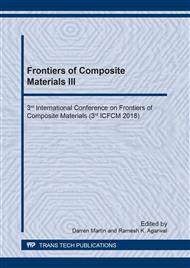[1]
S. Ming-Twang, Q. Zhi-Yong, L. Lin-Zhi, A.Y. Pei-Yee, M.A.A. Zaini. Dyes in water: Characteristics, impacts to the environment and human health, and the removal strategies. In: Advances in Chemistry Research Vol. 23. J.C. Taylor (Ed.), Nova Science Publishers, Inc., New York, (2015) 143-156.
Google Scholar
[2]
T. Shu-Hui, M.A.A. Zaini. Dyes - Classification and effective removal techniques. In: Advances in Chemistry Research Vol. 30. J.C. Taylor (Ed.), Nova Science Publishers, Inc., New York, (2016) 19-34.
Google Scholar
[3]
S. Ming-Twang, L. Lin-Zhi, M.A.A. Zaini, Q. Zhi-Yong, A.Y. Pei-Yee. Activated carbon for dyes adsorption in aqueous solution. In: Advances in Environmental Research Vol. 36. J.A. Daniels (Ed.), Nova Science Publishers, Inc., New York, (2015) 217-234.
Google Scholar
[4]
S. Ming-Twang, M.A.A. Zaini, L.M. Salleh, M.A.C. Yunus, M. Naushad. Potassium hydroxide-treated palm kernel shell sorbents for the efficient removal of methyl violet dye, Desalination and Water Treatment, 84 (2017) 262-270.
DOI: 10.5004/dwt.2017.21206
Google Scholar
[5]
L. Lin-Zhi, M.A.A. Zaini. Adsorption properties of cationic rhodamine B dye onto metals chloride-activated castor bean residue carbons, Water Science and Technology, 75(4) (2017) 864-880.
DOI: 10.2166/wst.2016.568
Google Scholar
[6]
M.J. Fernández-Berridi, N. González, A. Mugica, C. Bernicot. Pyrolysis-FTIR and TGA techniques as tools in the characterization of blends of natural rubber and SBR, Thermochimica Acta, 444(1) (2006) 65-70.
DOI: 10.1016/j.tca.2006.02.027
Google Scholar
[7]
P.T. Williams, S. Besler. Pyrolysis-thermogravimetric analysis of tyres and tyre components, Fuel, 74(9) (1995) 1277-1283.
DOI: 10.1016/0016-2361(95)00083-h
Google Scholar
[8]
T.S. Hui, M.A.A. Zaini. Potassium hydroxide activation of activated carbon: A commentary, Carbon Letters, 16(4) (2015) 275-280.
DOI: 10.5714/cl.2015.16.4.275
Google Scholar
[9]
M.A.A. Zaini, N.A. Mohamad. Activated charcoal for oral medicinal purposes: Is it really activated? Journal of Applied Pharmaceutical Science, 5(10) (2015) 157-159.
DOI: 10.7324/japs.2015.501028
Google Scholar
[10]
M.A.A. Zaini, M. Zakaria, S.H. Mohd-Setapar, M.A.C. Yunus. Sludge-adsorbents from palm oil mill effluent for methylene blue removal, Journal of Environmental Chemical Engineering, 1(4) (2013) 1091-1098.
DOI: 10.1016/j.jece.2013.08.026
Google Scholar
[11]
M.A.A. Zaini, R.M. Sudi. Valorization of human hair as methylene blue dye adsorbents, Green Processing and Synthesis, (2018).
DOI: 10.1515/gps-2017-0021
Google Scholar


